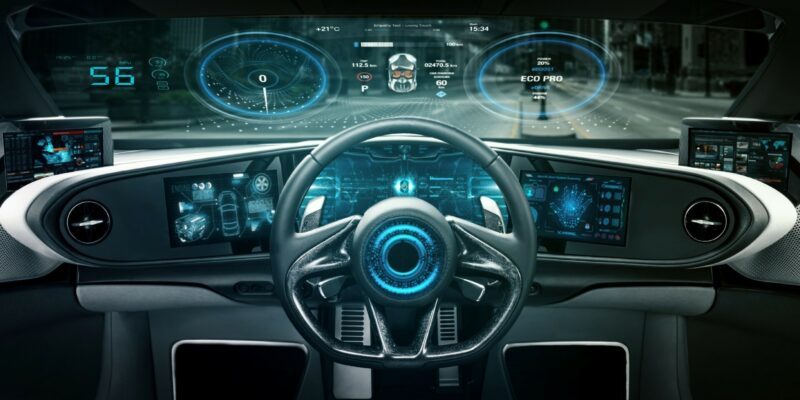
Modern-day vehicles are so advanced that we rarely stop to think about just how much tech comes built in as standard. What was classed as a ground-breaking innovation 20 years ago is now shrugged off as a run-of-the-mill specification that you’d expect to see on most makes and models.
Many of those features that we now take for granted were actually pioneered for use at the very elite echelons of motorsport. Of course, Formula One is a sport that has been transformed in recent years, as continual technological advances mean the likes of Lewis Hamilton and Max Verstappen are now racing in cars that are faster, lighter and safer.
As F1 has made great strides forward, road car manufacturers have taken inspiration and modified their offerings accordingly to meet the needs of an increasingly tech-savvy audience. So, what are some examples of racing technology in road cars? And what about the adaptation of F1 technology in everyday life? You might just be surprised…
Rear-view mirrors
All modern-day vehicles are now fitted with rear-view mirrors, but they’re an innovation that can be traced back to the early 20th century, when Ray Harroun mounted one on the front of his car for the inaugural Indianapolis 500 in 1911.
Harroun’s idea meant that, unlike his rivals, he did not have to have a second driver in the car with him and it certainly seemed to work as he went on to claim victory. It’s one of the earliest examples of racing technology that was used in road cars and Harroun’s triumphant Marmon Wasp is a permanent exhibit at the Indianapolis Motor Speedway Museum.
Active suspension
When Nigel Mansell won the F1 world championship in 1992, his Williams featured ground-breaking suspension technology. It allowed the level of the car’s chassis to be altered depending on the various road conditions, and it helped Mansell dominate the campaign.
He won nine of the 16 races and his overall points tally of 108 was only one fewer than his closest two competitors combined. Nowadays, active suspension is a common specification in road vehicles and a prime example of F1 car technology that has permeated its way into mass production.
Paddle shifters
Paddle shifters were first introduced by Ferrari and offered much faster gear changes due to the fact they were motorised and did not require the driver to take their hands off the wheel. Nowadays, they’re in every cockpit on the grid and are a popular option among the many everyday drivers who prefer the convenience and greater control that comes with keeping two hands firmly on the wheel.
Steering wheels
Ok, so not the steering wheels themselves – more so the controls and configurations that they feature. Since the turn of the century, F1 cars have boasted multi-functional steering wheels that allow the driver to change various settings at the touch of a button – a development that has been replicated in our everyday vehicles.
More recently, F1 wheels have even been designed to light up to reflect any flags that might be affecting a race. Perhaps it won’t be too much longer until we see that racing technology in road cars, to warn of any upcoming traffic light signals.
Carbon fibre
Back in the 1980s, it was McLaren who pioneered the carbon fibre chassis on the F1 grid. Its lightweight yet robust properties made it the ideal choice for teams looking to improve their times and protect their drivers’ safety. Carbon fibre is now a commonplace material in road cars, with many luxury brands such as Porsche, BMW, Jaguar and Aston Martin all using carbon fibre as part of their manufacturing process.
F1 technology in everyday life
Away from our cars, there are also quite a few examples of F1 technology being used in everyday life. Hospitals are utilising McLaren’s systems to monitor patients’ data, while sensors are also being placed on surgeons to provide specific feedback as they work inside the operating theatre.
The concepts and technology that underpin various teams’ pit-stop efficiency is also being harnessed in manufacturing plants to improve both the quality and the volume of production, as well as in medical facilities to enhance communication among staff members.
Racing technology in road cars from Jardine Motors
Ok, so you might not be able to hurtle around the track at 200mph like Lewis Hamilton but, as we’ve seen, you can still enjoy plenty of F1 technology in road cars. At Jardine Motors, we stock thousands of new and used models from premium brands, including Mercedes-Benz, MINI, Land Rover and Audi – not to mention our extensive collection of electric vehicles.
You too could benefit from the increasing prevalence of racing technology in road cars, so why not contact your local dealership or get in touch with a member of our friendly team to find out more.
You Might Also Like
The Drivers Who Shaped British Grand Prix History
The Best Car Gadgets For Your Ride
Visit our YouTube channel where you can find car reviews and expert advice.



